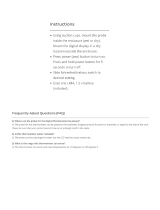
OMEGA Model CYD201/CYD208 User’s Manual
A
WARRANTY
OMEGA warrants this unit to be free of defects in materials and workmanship and to give
satisfactory service for a period of 13 months from date of purchase. OMEGA Warranty adds an
additional one (1) month grace period to the normal one (1) year product warranty to cover handling
and shipping time. This ensures that our Customers receive maximum coverage on each product. If
the unit should malfunction, it must be returned to the factory for evaluation. Our Customer Service
Department will issue an Authorized Return (AR) Number immediately upon phone or written
request. Upon examination by OMEGA, if the unit is found to be defective, it will be repaired or
replaced at no charge. However, this WARRANTY is VOID if the unit shows evidence of having
been tampered with or shows evidence of being damaged as a result of excessive current, heat,
moisture, vibration, or misuse. Components which wear or which are damaged by misuse are not
warranted. These include contact points, fuses, and triacs.
THERE ARE NOT WARRANTIES EXCEPT AS STATED HEREIN. THERE ARE NO OTHER
WARRANTIES, EXPRESSED OR IMPLIED, INCLUDING BUT NOT LIMITED TO THE IMPLIED
WARRANTIES OF MERCHANTABILITY AND OF FITNESS FOR A PARTICULAR PURPOSE. IN
NO EVENT SHALL OMEGA ENGINEERING, INC. BE LIABLE FOR CONSEQUENTIAL,
INCIDENTAL, OR SPECIAL DAMAGES. THE BUYER'S SOLE REMEDY FOR ANY BREACH OF
THIS AGREEMENT BY OMEGA ENGINEERING, INC., OR ANY BREACH OF ANY WARRANTY
BY OMEGA ENGINEERING, INC., SHALL NOT EXCEED THE PURCHASE PRICE PAID BY THE
PURCHASE TO OMEGA ENGINEERING, INC. FOR THE UNIT OR UNITS OR EQUIPMENT
DIRECTLY AFFECTED BY SUCH BREACH.
RETURN REQUESTS / INQUIRIES
Direct all warranty and repair requests/inquiries to the OMEGA Customer Service Department.
Call toll free in the USA and Canada: 1-800-622-2378; FAX: 203-359-7811.
International:
203-359-1660; FAX; 203-359-7806.
BEFORE RETURNING ANY PRODUCT(S) TO OMEGA,
OBTAIN AN AUTHORIZED RETURN
(AR) NUMBER FROM OUR CUSTOMER SERVICE DEPARTMENT IN ORDER TO AVOID
PROCESSING DELAYS
. The assigned AR number should then be marked on the outside of the
return package and on any correspondence.
FOR WARRANTY RETURNS:
Please have the following information available BEFORE contacting
OMEGA:
1. P.O. Number under which the product was PURCHASED.
2. Model and serial number of the product under warranty.
3. Repair instruction and/or specific problems you are having with the product.
FOR NON-WARRANTY REPAIRS OR CALIB4RATIONS:
Consult OMEGA for current
repair/calibration charges. Have the following information BEFORE contacting OMEGA:
1. Your P.O. Number to cover COST of the repair/calibration..
2. Model and serial number of the product under warranty.
3. Repair instruction and/or specific problems you are having with the product.
Every precaution for accuracy has been taken in the preparation of this manual, however, OMEGA
ENGINEERING, INC. neither assumes responsibility for any omissions or errors that may appear
nor assumes liability for any damages that result from the use of the products in accordance with
the information contained in the manual.
OMEGA policy is to make running changes, not model changes, whenever an improvement is
possible. That way, our Customers get the latest in technology and engineering.
OMEGA is a registered trademark of OMEGA ENGINEERING, INC.
© 1998 and 1999 OMEGA ENGINEERING, INC. All rights reserved including illustrations. Nothing
in this manual may be reproduced in any manner, either wholly or in part for any purpose
whatsoever without written permission from OMEGA ENGINEERING, INC. Printed in U.S.A.























